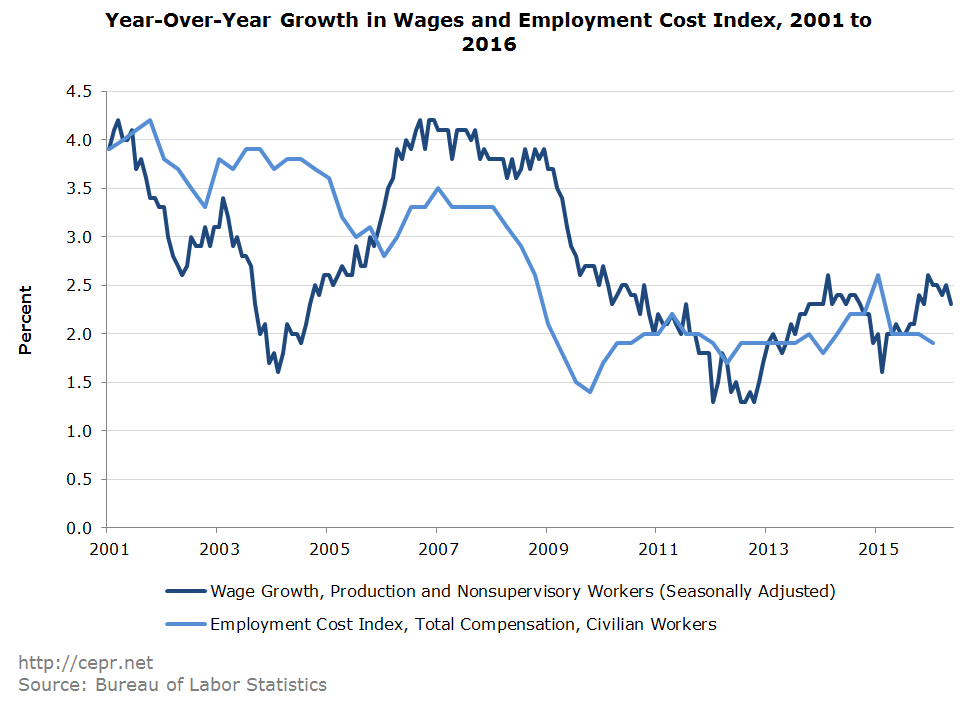July 08, 2016
July 8, 2016 (Jobs Byte)
By Dean Baker
EPOPs of college grads are down over the year, but up for workers with less education.
The Labor Department reported that the economy added 287,000 jobs in June, a sharp bounce back from the 11,000 jobs now reported for May. A big factor in the reversal was the end of the Verizon strike, which subtracted 37,000 jobs from the May growth number and added the same amount in June, but even adjusting for this effect, the June growth figure is much stronger.
The job gains were widely spread across sectors. Health care added 38,500 jobs, roughly the same as its 40,100 average over the last year. Retail added 29,900, while the government sector added 22,000, with 17,000 at the local government level. Manufacturing added 14,000 jobs with 13,000 of these in food manufacturing. Food manufacturing has added more than 50,000 jobs over the last two years, with employment levels now 2.7 percent above the pre-recession peak. Arts and entertainment added 27,200 jobs, but this was largely just a reversal of a reported drop of 13,600 jobs in May.
Construction was flat, and mining lost another 6,400 jobs in June. Employment in the sector is down by 211,300 (24.8 percent) from its peak in September of 2014.
Trucking lost 6,300 jobs, its fifth consecutive month of job loss. Interestingly, warehousing and storage added 4,700 jobs in June. Employment in the sector is now more than 180,000 (27.2 percent) above its pre-recession peak. It’s not clear if any of this growth could be a trade-off for trucking jobs. Non-supervisory workers in warehousing average $15.82 an hour compared with $21.21 in the trucking industry.
The average hourly wage is 2.6 percent above its year-ago level. In the last three months, it has risen at a 2.7 percent annual rate compared with its level for the prior three months. While there has been some acceleration in wage growth by this measure, the Employment Cost Index shows no upward trend whatsoever. Clearly compensation is being shifted in part from benefits, most importantly health care, into wages. It is important not to mistake this shift for an increase in labor costs.

The household survey showed a bleaker picture. The unemployment rate rose modestly to 4.9 percent. The employment-to-population ratio (EPOP) fell to 59.6 percent as employment measured by the household survey increased by just 67,000. Employment in the household survey is still more than 200,000 below its March level.
By demographic group, the most disturbing item is the reported rise in the unemployment rate among black teens to 31.2 percent. It had been 23.3 percent in February. These data are highly erratic, but the trend is large enough that it could reflect a substantial deterioration in the labor market.
Employment patterns by education are showing an interesting pattern in this recovery. Over the last year the unemployment rate for college grads has not changed while their EPOP is down by 0.3 percentage points. By contrast, the unemployment rate for those with a high school degree has fallen by 0.4 percentage points and by 0.6 percentage points for those with less than a high school degree. Their EPOPs have risen by 0.3 and 1.2 percentage points, respectively. The increased demand for skills is not obvious in this picture.
Other aspects of the household survey were mixed. There was a drop of 587,000 in the number of people working involuntarily part-time, which more than reversed a sharp rise reported for May. The number of discouraged workers is more than 150,000 below its year-ago level and not too far above pre-recession levels. The duration measures of unemployment were mixed. The median duration of unemployment spells fell slightly to 10.3 weeks, a new low for the recovery, but both the average duration and share of long-term unemployed rose slightly.
The percentage of unemployment due to voluntary quits remained constant at 10.7 percent. This is near the high for the recovery, but still far below pre-recession levels.
On the whole, this should be seen as a modestly positive report. The job growth in the establishment survey was impressive, but it still only brings the three-month average to 147,300. At the same time, the household survey is indicating a much weaker picture. The establishment survey is generally a better measure, but even the establishment survey is not showing strong job growth over the three-month period.






